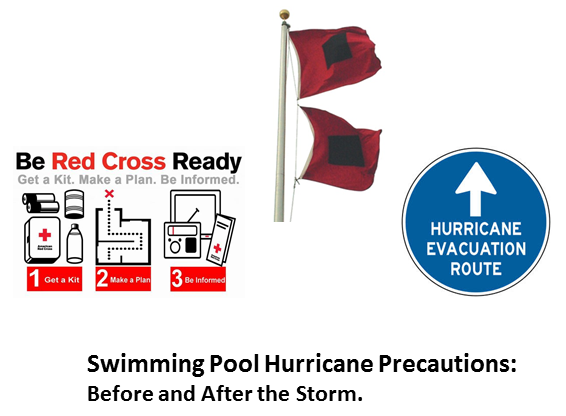
People may ask, “Won’t the pool overflow if we don’t, at least, lower the water?” Yes it may, but no more so than if a patio or a plot of grass were there instead. Adequate drainage has most always been provided for in the design of the pool. Keeping the water in the pool provides the important weight to hold the pool in the ground. An empty pool is subject to “floating” or “popping” out of the ground due to “lift” pressure from excessive ground water caused by the heavy rains that may accompany the storm.
Circuit breakers at the main electrical panel should be turned off to prevent pump motors, lighting, chlorinators, and heaters from operating.
Wrap the pump motor, time clock, light transformers and electric heaters with a waterproof plastic membrane and tie it securely in place to prevent sand and driving water from entering. If flooding is expected, it may be best to disconnect these devices and store them in a dry place.
Loose objects such as chairs, tables, toys and pool tools which can become dangerous projectiles in high winds should be stored inside of buildings. It’s not advisable to throw patio furniture into the pool unless it is a last resort. If it is necessary to do so, gently place these items into the pool to prevent possible damage to the interior finish and remove as soon as possible to avoid staining.
Some damage to the frame of the screen structure may be prevented if you provide a “vent” for wind to flow through. Consider removing screen panels on opposite sides of the enclosure by pulling out the vinyl spine that retain the panels.
It would be instinct to run out and close or put on the swimming pool cover when a storm is coming. DO NOT DO IT! Storms bring wind, and wind can cause falling branches and other flying debris that can damage pool covers. It’s much easier to remove debris from the pool after the storm, than it would be to replace an expensive cover.
Swimming Pool Hurricane Precautions – After the Storm
As Before the Storm, Do Not Empty the Pool
An empty pool is subject to “floating” or “popping” out of the ground due to “lift” pressure from excessive ground water caused by heavy rains that may have accompanied the storm. If it appears necessary to drain the pool due to excessive debris and/or damage, you should seek professional advice.
Remove large objects by hand and use a “pool rake” or “skimmer net” to remove smaller debris from the pool. Do not attempt to use the pool’s vacuum system for debris that is likely to plug the plumbing.
Remove waterproof plastic membrane from electrical devices and be sure they are dry before turning circuit breakers on again. If these devices have been exposed to water, they should be checked by a licensed professional. Then turn on electricity, prime the filter system, and check for normal operation.
Clean the filter and run the system 24 hours a day. When the water has attained proper clarity then reset the time clock for a normal daily cycle.
It is important to monitor the overall operation of the entire system for several days after the storm to be sure everything is operating properly.
